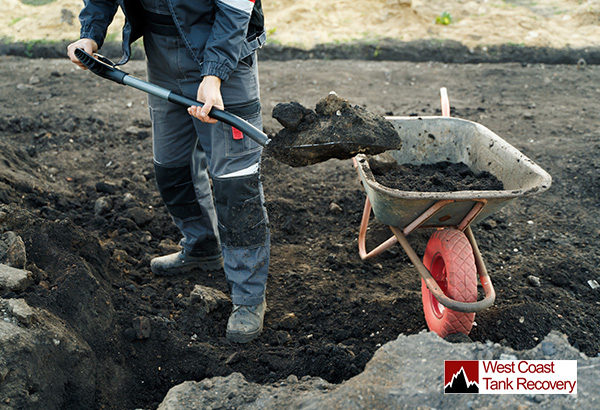 Fully Licensed and Insured
Fully Licensed and Insured Request an Oil Tank Scan
Request an Oil Tank Scan Request a Free Estimate
Request a Free Estimate

Contaminated soil is a significant environmental concern for our ecosystems and communities as it harbours pollutants that can pose serious risks to our health. Soil contamination occurs when hazardous substances such as heavy metals, pesticides, or industrial chemicals, exceed permissible levels. This is often due to improper disposal, industrial activities, or accidental spills. Unfortunately, this contamination can have detrimental consequences thereby affecting the quality of groundwater and potentially entering the food chain. Luckily, the process of contaminated soil remediation can address the issue of protecting the health of our environment and the safety of communities. Here’s how it works!
A thorough site assessment is the crucial first step in the process of contaminated soil remediation. Site assessments conducted by professionals are an essential process in the journey toward restoration. At West Coast Tank Recovery, our team is trained to use specialized equipment and techniques to determine the complexities of contaminated sites. This is the most efficient way to assess potential risks to human health and the environment. Site assessments conducted by professional environmental companies are crucial to successful soil remediation endeavours ensuring that the restoration process follows environmental regulations and best practices.
Bioremediation is an important soil remediation technique. This process is both remarkable and eco-friendly using the power of living organisms to reduce soil contamination and restore the health of the environment. In this process, bacteria, fungi, and plants are strategically placed in the contaminated site. These natural materials then break down various pollutants within the soil transforming them into less harmful substances. Bioremediation offers a sustainable alternative to traditional cleanup methods, reducing the need for excavation and disposal. Its versatility, cost-effectiveness, and minimal environmental impact make it a promising contaminated soil remediation technique.
This method involves introducing specific chemicals into the affected soil to break down contaminants. Common chemicals used in this process include hydrogen peroxide, ozone, and persulfate. This technique is particularly beneficial for treating complex contamination sites. Chemical treatments offer precision and efficiency, reducing the environmental impact of contaminants while minimizing the need for excavation. This contaminated soil remediation strategy is all about effectiveness, playing an important role in the concerted effort to restore soil health.
Continuous monitoring of soil sites allows environmental professionals to track the changes in soil and groundwater quality over time providing valuable insights into the changing condition of the site. This is a mandatory piece of the soil remediation process as it shows whether or not goals are being met ensuring the site is returning to a healthier state.
Successful soil remediation holds major importance for both environmental sustainability and human well-being. Contaminated soil poses significant threats to our ecosystems and biodiversity, leading to negative effects on plant and animal life. Through successful remediation, we not only lower these environmental risks but also restore the natural balance of ecosystems. Many contaminants can leach into water sources or accumulate in crops entering the human food chain and posing health risks to those who consume contaminated products. By ensuring successful contaminated soil remediation, we protect the quality of our air, water, and food supply.
Whether you are seeking oil tank removal from your property, soil testing consultation, or need an assessment certifying your property to be oil-tank-free, we can help! Give us a call today and speak with our team of trusted specialists.